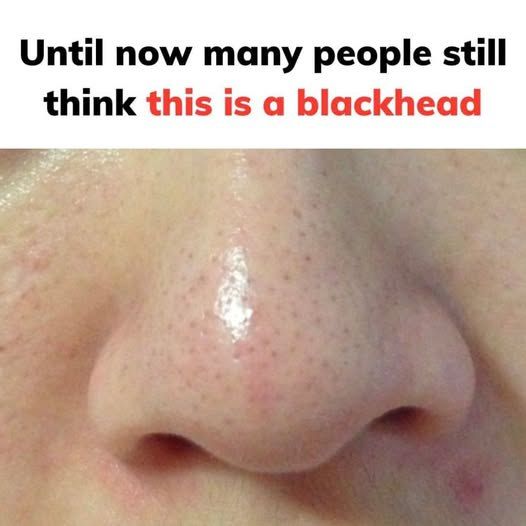Don’t Be Fooled by Filters and Airbrushed Photos – Real Skin Has Texture!
Let’s face it—skin is never as flawless as we see in filters or celebrity photos. It has natural texture, from darker pigmentation around the eyes to the occasional puffiness, wrinkles, freckles, beauty marks, or even bumps. All of these are completely normal and part of what makes your skin unique. However, some skin issues, like severe acne or dry patches, can signal a deeper problem. With the unrealistic standards set by perfectly smooth, flawless skin, it’s easy to mistake natural skin features for something unhealthy. Take sebaceous filaments, for example. While they might look like pesky blackheads, they actually serve a vital function for your skin’s health.
So, what exactly are sebaceous filaments?

You’ve probably noticed tiny dots across your face, particularly around the nose, cheeks, chin, and forehead. But before you reach for that extractor tool, don’t mistake them for clogged pores or blackheads. Chances are, they’re sebaceous filaments—natural, tube-like structures within your pores that actually play a key role in keeping your skin healthy.
“Although sebaceous filaments might resemble blackheads, they’re usually a bit darker or grayer in color, unlike the typical blackhead,” explains Dr. Dendy Engelman, a board-certified dermatologist based in New York City. “These filaments serve a vital purpose—they transport oil from your sebaceous glands to the surface of your skin, helping to keep your skin hydrated and protected from damage.”
So, before you try to pop or pick them, remember: sebaceous filaments are a completely natural part of your skin’s anatomy, and they shouldn’t be messed with!

Although they may look similar, sebaceous filaments and pimples are two entirely different things. “A pimple is caused by bacteria or fungus, often appearing as a fleshy bump with a white or black tip—hence the terms whitehead or blackhead,” explains Dr. Purvisha Patel, a board-certified dermatologist at Skin Wellness Dermatology. “On the other hand, sebaceous filaments are made up of just oil and keratin—no bacteria involved. They’re completely harmless.”
While sebaceous filaments might not be the most attractive feature on your skin, they’re not a cause for concern. Unlike persistent acne, they don’t require a visit to the dermatologist.
Who Gets Sebaceous Filaments?

While everyone has sebaceous filaments, they’re more noticeable on some people than others. Genetics and age play major roles in how visible these filaments are. For example, people with thicker hair follicles may have more prominent filaments, and during puberty, sebaceous glands become larger and more noticeable. As we age and our skin starts to sag and loosen, pores can expand, making sebaceous filaments more apparent.
One factor you can control is how you care for your skin. According to the Cleveland Clinic, dry skin caused by too much sun exposure or over-washing can make sebaceous glands work overtime, leading them to grow bigger as they try to keep your skin hydrated.
Should You Remove Sebaceous Filaments?

You’ve likely come across videos showing people pulling out sebaceous filaments—while they may seem oddly satisfying (and a bit gross), skincare experts strongly advise against it. For one, these thread-like structures are essential for keeping your skin naturally moisturized and soft, as they help lubricate your pores.
What’s more, even if you manage to remove them, they won’t stay gone for long. Within a month, the follicle will fill up with sebum again, and your skin will look just as it did before. A more effective solution is using a gentle cleanser designed to reduce pore size—while it won’t make them completely vanish, it can help minimize their appearance.
The Risks of Skin Damage

Squeezing sebaceous filaments might seem tempting, but it can actually do more harm than good. Dr. Joshua Zeichner, a board-certified dermatologist in New York City, warns, “Applying too much pressure can damage the outer layer of your skin, causing breakages, scabs, or even infections.” Other potential side effects include redness, inflammation, hyperpigmentation, pimples, and scarring. So, rather than poking and pinching at your skin, it’s best to leave it alone and consult a professional if you want them removed safely.
What About “Skin Gritting”?

Lately, beauty influencers have been pushing a trend called “skin gritting,” claiming it can eliminate sebaceous filaments. The process typically involves softening the skin with an oil cleanser, applying an acid exfoliant, layering on a clay product with essential oils, and then massaging the face with the oil cleanser for up to 15 minutes.
But is it really effective, or just excess product piling up on your skin?
Grit or Just Product Build-Up?

Dr. Engelman weighs in: “While combining exfoliating acids, purifying masks, and oils might give you a deeper clean by pulling out pore-clogging material, much of the blackhead-like gunk you’re seeing is likely just excess product you’ve applied.” Over time, this approach could even backfire, making your skin appear looser and pores look larger.
How to Clean Sebaceous Filaments Properly

Remember, sebaceous filaments are a natural and healthy part of your skin’s makeup. While social media influencers may promise flawless, untextured skin, that’s not the reality of how skin works. Instead of chasing an unattainable “perfect” complexion, focus on nurturing your skin’s health.
The good news is, you can build a skincare routine that helps minimize the appearance of sebaceous filaments. Look for products that contain ingredients like alpha hydroxy acids, oil-absorbing clay, retinol, salicylic acid, sulfur, and vitamin E. On the flip side, steer clear of pore-clogging ingredients like petroleum, coconut oil, shea butter, and tea tree oil. Keep your face-washing routine simple—more isn’t always better. And remember, when introducing new products, take it slow to ensure they’re actually benefiting your skin and not making things worse.
